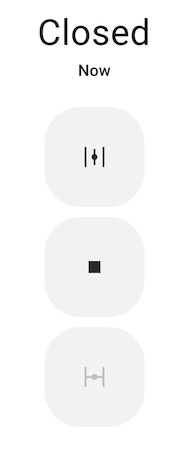Template Valve
The template valve platform allows you to create simple valves out of just a few actions and a value lambda. Once
defined, it will automatically appear in Home Assistant as a valve and can be controlled through the frontend.

# Example configuration entry
valve:
- platform: template
name: "Template Valve"
lambda: |-
if (id(top_end_stop).state) {
return VALVE_OPEN;
} else {
return VALVE_CLOSED;
}
open_action:
- switch.turn_on: open_valve_switch
close_action:
- switch.turn_on: close_valve_switch
stop_action:
- switch.turn_on: stop_valve_switch
optimistic: truePossible return values for the optional lambda:
return VALVE_OPEN;if the valve should be reported as OPEN.return VALVE_CLOSED;if the valve should be reported as CLOSED.return {};if the last state should be repeated.
Configuration variables
lambda (Optional, lambda): Lambda to be evaluated repeatedly to get the current state of the valve.
open_action (Optional, Action): The action that should be performed when the remote (like Home Assistant’s frontend) requests the valve to be opened.
close_action (Optional, Action): The action that should be performed when the remote requests the valve to be closed.
stop_action (Optional, Action): The action that should be performed when the remote requests the valve to be stopped.
optimistic (Optional, boolean): Whether to operate in optimistic mode - when in this mode, any command sent to the template valve will immediately update the reported state and no lambda needs to be used. Defaults to
false.restore_mode (Optional, enum): Control how the valve attempts to restore state on bootup.
NO_RESTORE(Default): Do not save or restore state.RESTORE: Attempts to restore the state on startup, but doesn’t instruct the valve to return to that state.RESTORE_AND_CALL: Attempts to restore the state on startup and instructs the valve to return to the restored state.
assumed_state (Optional, boolean): Whether the true state of the valve is not known. This will make the Home Assistant frontend show buttons for both OPEN and CLOSE actions, instead of hiding one of them. Defaults to
false.has_position (Optional, boolean): Whether this valve will publish its position as a floating point number. By default (
false), the valve only publishes OPEN/CLOSED position.position_action (Optional, Action): The action that should be performed when the remote (like Home Assistant’s frontend) requests the valve be set to a specific position. The desired position is available in the lambda in the
posvariable. Requireshas_position(above) to be set totrue.All other options from Valve.
valve.template.publish Action
You can also publish a state to a template valve from elsewhere in your YAML filewith the valve.template.publish action.
# Example configuration entry
valve:
- platform: template
name: "Template Valve"
id: my_template_valve
# in some trigger
on_...:
- valve.template.publish:
id: my_template_valve
state: OPEN
# Templated
- valve.template.publish:
id: my_template_valve
state: !lambda 'return VALVE_OPEN;'Configuration options:
id (Required, ID): The ID of the template valve.
state (Optional, templatable): The state to publish. One of
OPEN,CLOSED. If using a lambda, useVALVE_OPENorVALVE_CLOSED.position (Optional, templatable, float): The position to publish, from 0 (CLOSED) to 1.0 (OPEN)
current_operation (Optional, templatable, string): The current operation mode to publish. One of
IDLE,OPENINGandCLOSING. If using a lambda, useVALVE_OPERATION_IDLE,VALVE_OPERATION_OPENING, andVALVE_OPERATION_CLOSING.
ℹ️ Note
This action can also be written in lambdas:
id(my_template_valve).position = VALVE_OPEN; id(my_template_valve).publish_state();

